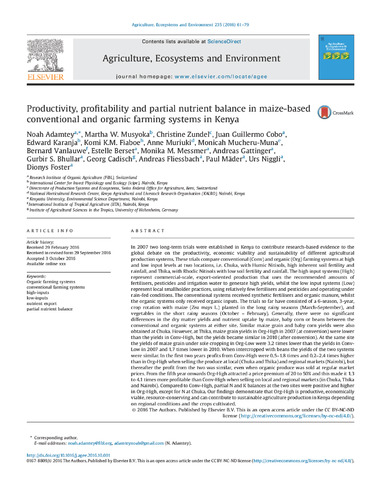Productivity, profitability and partial nutrient balance in maize-based conventional and organic farming systems in Kenya
Abstract
In 2007 two long-term trials were established in Kenya to contribute research-based evidence to the global debate on the productivity, economic viability and sustainability of different agricultural production systems. These trials compare conventional (Conv) and organic (Org) farming systems at high and low input levels at two locations, i.e. Chuka, with Humic Nitisols, high inherent soil fertility and rainfall, and Thika, with Rhodic Nitisols with low soil fertility and rainfall. The high input systems (High) represent commercial-scale, export-oriented production that uses the recommended amounts of fertilisers, pesticides and irrigation water to generate high yields, whilst the low input systems (Low) represent local smallholder practices, using relatively few fertilisers and pesticides and operating under rain-fed conditions. The conventional systems received synthetic fertilisers and organic manure, whilst the organic systems only received organic inputs. The trials so far have consisted of a 6-season, 3-year, crop rotation with maize (Zea mays L.) planted in the long rainy seasons (March-September), and vegetables in the short rainy seasons (October – February). Generally, there were no significant differences in the dry matter yields and nutrient uptake by maize, baby corn or beans between the conventional and organic systems at either site. Similar maize grain and baby corn yields were also obtained at Chuka. However, at Thika, maize grain yields in Org-High in 2007 (at conversion) were lower than the yields in Conv-High, but the yields became similar in 2010 (after conversion). At the same site the yields of maize grain under sole cropping in Org-Low were 3.2 times lower than the yields in Conv-Low in 2007 and 1.7 times lower in 2010. When intercropped with beans the yields of the two systems were similar. In the first two years profits from Conv-High were 0.5–1.8 times and 0.2–2.4 times higher than in Org-High when selling the produce at local (Chuka and Thika) and regional markets (Nairobi), but thereafter the profit from the two was similar, even when organic produce was sold at regular market prices. From the fifth year onwards Org-High attracted a price premium of 20 to 50% and this made it 1.3 to 4.1 times more profitable than Conv-High when selling on local and regional markets (in Chuka, Thika and Nairobi). Compared to Conv-High, partial N and K balances at the two sites were positive and higher in Org-High, except for N at Chuka. Our findings demonstrate that Org-High is productive, economically viable, resource-conserving and can contribute to sustainable agriculture production in Kenya depending on regional conditions and the crops cultivated.

